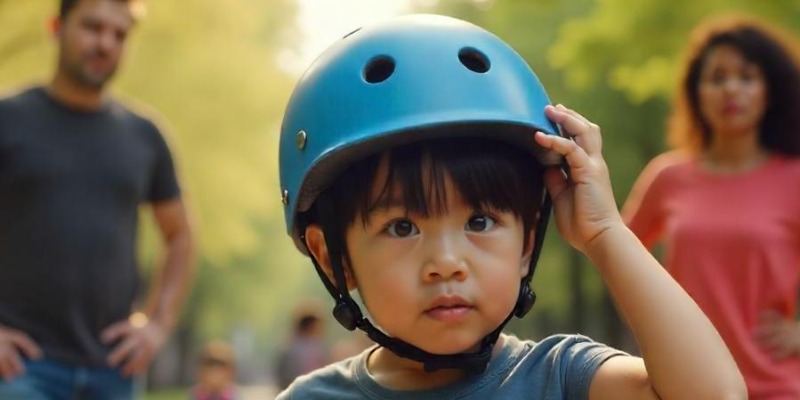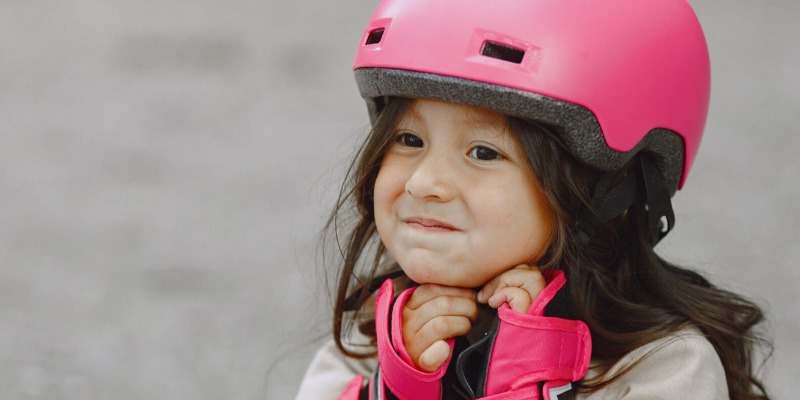10 Tips To Get Your Child To Wear a Helmet
It’s no secret! You must know the ordeal if you are a child's parent or guardian. Kids don't always love wearing helmets (even though helmets can be lifesavers!).
Let's imagine a typical day with your child. Your child is energetic and eager to jump on the bike or scooter for a fun ride.
But as soon as you mention "helmet," the excitement fades away. Suddenly, this simple safety hat turns into a mini standoff.
As parents or guardians, we often find ourselves in such circumstances. There is a constant back-and-forth scuffle. Every time your child hops on their bike, you brace yourself for the inevitable argument—the annoying tug-of-war.
But what if there was a way to make helmet-wearing as exciting as the ride?
Are you looking for simple, fun strategies to keep your child safe—without the daily struggle?
Here are ten proven tips to help your child wear a helmet quickly—and maybe even a smile!

Make Helmets Fun With Cool Designs
Getting your child to wear a helmet is easier than you think. This is true when you make it a fun accessory. Eliminate the dull part.
Make your helmet shopping into a special event. Take them along and find one they love to wear.
Ideas to try:
Let them pick a helmet featuring their favourite characters (superheroes, cartoon characters, animals, or princesses).
Choose helmets with cool features like dinosaur spikes or glittery designs.
Use custom stickers or decals to increase the personal touch of any helmet.
Let Them Be The Decision-Maker In The Helmet Business
When children are in control, they feel happy.
Give your child the freedom to pick out their helmet, decide how to wear it, and watch their excitement grow.
Ideas to try:
Make a trip to the store and let them try on different helmets.
Offer a few helmet options and let them pick their favourite.
Make them the "safety boss" who also reminds everyone else to wear helmets!
Show Them You Wear One Too
Kids are known to copy their parents or siblings. They will surely want to imitate you if they see you wearing a helmet or an older brother or sister.
Hence, try to be a role model in wearing a helmet. Make it a family rule.
Ideas to try:
Without exceptions, always wear your helmet every time you ride.
Plan a family bike ride. Make sure everyone wears helmets.
Talk about how helmets protect everyone. They are not just for kids.
Explain Why Helmets Are Important
Sometimes, a simple one-to-one conversation can go a long way.
Talk to your child at their level. Explain why helmets are so important and show how they keep riders' heads safe.
Ideas to try:
Use relatable analogies, like comparing a helmet to armour for their brain.
Set a rule: no helmet, no ride—plain and simple.
Share age-appropriate stories about how helmets have saved lives.
Reward Good Behavior
Positive support works wonders!
Starting a reward system when teaching a child something is always productive. In this case, you can make wearing a helmet a positive act.
Let your child know they will earn points or fun prizes if they wear a helmet. This will keep them motivated.
Ideas to try:
Start a helmet-wearing chart and give them a sticker every time they wear it.
Promise a special treat after a week of consistent helmet-wearing.
Plan a fun family outing as a reward for their safety efforts.
Promote Wearing Helmets In Early Age
Start early in their age. The earlier you start to motivate them, the faster it is to make helmet-wearing second nature.
Infuse the habit in the children when they are young. This will ensure they will grow up with it as a routine.
Ideas to try:
Begin with helmets on tricycles or balance bikes.
Create helmet-themed games for toddlers, like a "superhero helmet race."
Make it part of their “getting ready” routine for every ride.
Choose The Perfect Fit
For a child, comfort is essential. The helmet should not be an irritant for the child.
Nothing is worse than an uncomfortable helmet. Make sure it is not tight or loose. A helmet that fits just right will keep your child calm and safe and reduce their likelihood of complaining about wearing it.
Ideas to try:
Ensure the helmet fits snugly. It should not be too tight or too loose.
Adjust the chin strap. It should form a comfortable “V” under their ears.
Check-in with them about how the helmet feels and make adjustments as needed.
Turn It Into a Game
Kids love playing games! Make helmet-wearing part of the child's playtime activity. You can also add role-playing. This will help quickly make it something they look forward to.
Ideas to try:
Create a "helmet race" where they must wear it in record time.
Turn them into a “safety superhero” who gains powers by wearing their helmet.
Make a fun competition: who can put on their helmet the fastest?
Show Them The Heroes Wear Helmets
Kids love to link themselves with their favourite characters or superheroes. They look up to the celebrities. Show them pictures and videos of the most incredible people wearing helmets. Teach them how they should, too!
Ideas to try:
Point out athletes or superheroes who always wear helmets (e.g., Tony Hawk or cartoon characters).
Watch videos of professional bikers or skaters wearing helmets.
Make a scrapbook with pictures of their favourite helmet-wearing stars.

Be Consistent: Keep Reinforcing The Habit
Consistency is key. It would help if you continued the efforts to form a lifelong habit.
Stick to your helmet rules. Do not compromise. Be firm but fun. Over time, helmet-wearing will become part of the ride.
Ideas to try:
Make it a family rule: no helmet, no activity—every single time.
Offer gentle reminders if they forget, but stick to the rule.
Stay positive, and celebrate their progress with lots of encouragement.
A Happy Child Wears a Happy Helmet!
Making a child wear a helmet is simple. It does not have to be a daily battle.
You can turn this into something your child looks forward to—it should not be something they dread. This can be done with a few clever tricks and some creativity.
So, next time your child reaches for their bike, scooter, or skateboard, he will be ready with a helmet. They may want to wear it themselves over time.





